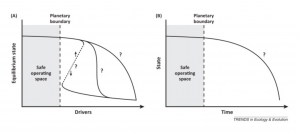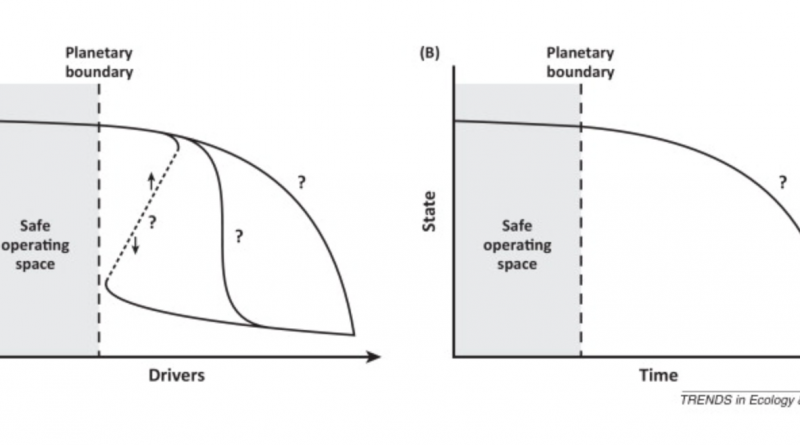Multiscale regime shifts and planetary boundaries
The earth and its subsystems have undergone many regime shifts (i.e., when a small change in a driving variable leads to a large change in the system). Regime shifts are sometimes difficult to recognize because they occur slowly in relation to the lifespan of humans but actually occur quickly in relation to geological timescale. One example of a regime shift is desertification which appears to happen quickly. Close inspection of desertification reveals that gradual changes in the climate, land surface and atmosphere, grazing patterns, and behavior of pastoralists act as fast-slow processes that gradually erode the resilience of the system. Major speciation events like the Cambrian Explosion, which occurred over evolutionary time scales and resulted in ecological change due to global warming, cooling, ocean acidification, habitat loss, annoxia, etc. are considered to be regime shifts.
The authors proposed the use of planetary boundaries to avert unwanted regime shifts in important natural systems. Planetary boundaries are safe operating zones for a system’s driving variable (see figure below). If the boundary is surpassed, the system is at risk of undergoing a regime shift. Since the location of the boundary is never precisely known it is important to set up the boundary sufficiently before. Setting the location of planetary boundaries for managing natural systems is made difficult by tipping points within driving variables and anthropogenic effects. For instance, the climate is a driver of many ecosystems but also exhibits a range of dynamic behaviors including tipping points. In addition, human globalization has important effects on ecological resilience and therefore where to set boundaries. For example, it’s usually predicted that increasing connectedness of a system is advantageous for promoting recovery via increased recruitment from other areas but can be disadvantageous if connectivity leads to the spread of disease and invasive species. A challenge within the social sciences is uniting governance bodies on agreements for planetary boundaries .
The interconnection between the climate, its sub-systems, ecosystems, and their management is an area of research that can only be tackled using multi-scale modeling. Open questions involve how tipping points in systems can be anticipated, how multiple drivers interact to cause tipping points, and how local tipping points scale up to global tipping points.


